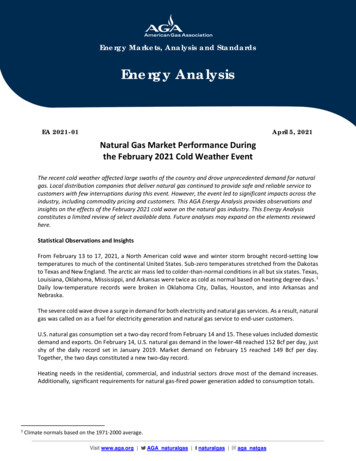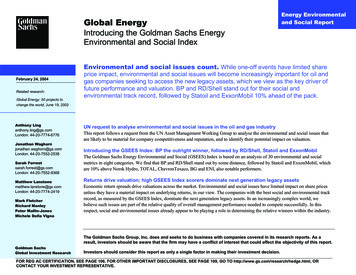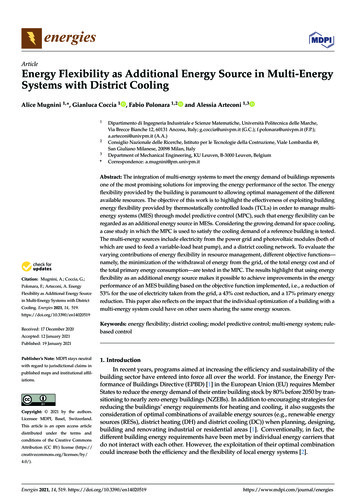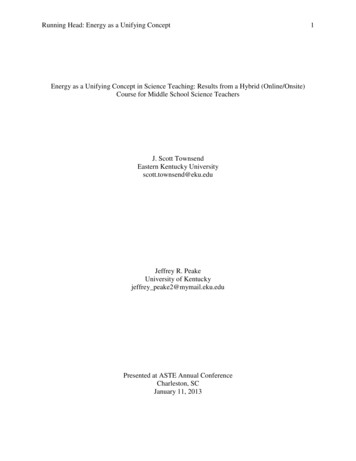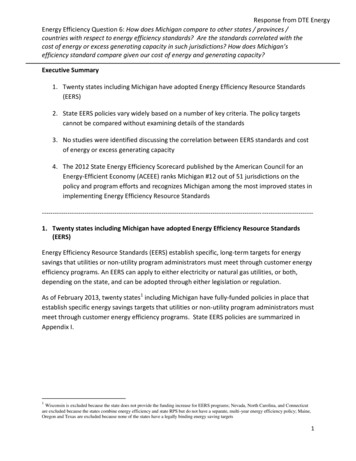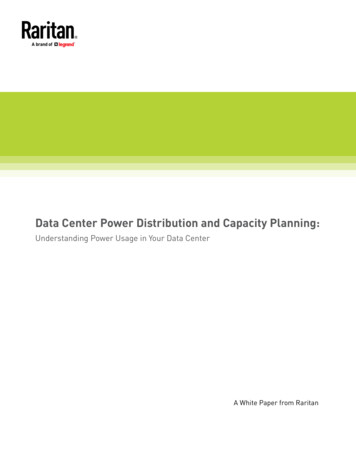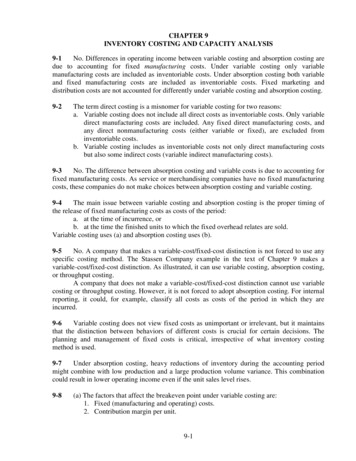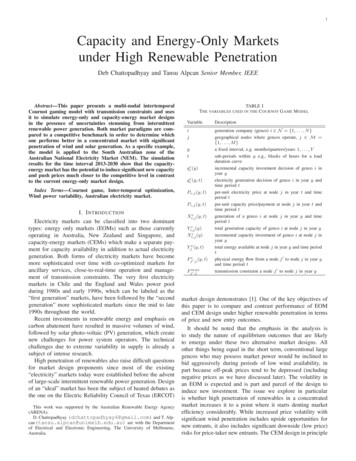
Transcription
1Capacity and Energy-Only Marketsunder High Renewable PenetrationDeb Chattopadhyay and Tansu Alpcan Senior Member, IEEEAbstract—This paper presents a multi-nodal intertemporalCournot gaming model with transmission constraints and usesit to simulate energy-only and capacity-energy market designsin the presence of uncertainties stemming from intermittentrenewable power generation. Both market paradigms are compared to a competitive benchmark in order to determine whichone performs better in a concentrated market with significantpenetration of wind and solar generation. As a specific example,the model is applied to the South Australian zone of theAustralian National Electricity Market (NEM). The simulationresults for the time interval 2013-2030 show that the capacityenergy market has the potential to induce significant new capacityand push prices much closer to the competitive level in contrastto the current energy-only market design.Index Terms—Cournot game, Inter-temporal optimization,Wind power variability, Australian electricity market.TABLE IT HE VARIABLES USED IN THE C OURNOT G AME M ODELVariableDescriptionijgeneration company (genco) i N {1, . . . , N }geographical nodes where gencos operate, j M {1, . . . , M }a fixed interval, e.g. months/quarters/years 1, . . . , Ysub-periods within y e.g., blocks of hours for a loadduration curveincremental capacity investment decision of genco i inyear yelectricity generation decision of genco i in year y andtime period tper-unit electricity price at node j in year t and timeperiod tper-unit capacity price/payment at node j in year t andtime period tgeneration of a genco i at node j in year y and timeperiod ttotal generation capacity of genco i at node j in year yincremental capacity investment of genco i at node j inyear ytotal energy available at node j in year y and time periodtphysical energy flow from a node j ′ to node j in year yand time period ttransmission constraint a node j ′ to node j in year yytqic (y)qie (y, t)Pe,j (y, t)Pc,j (y, t)I. I NTRODUCTIONElectricity markets can be classified into two dominanttypes: energy only markets (EOMs) such as those currentlyoperating in Australia, New Zealand and Singapore, andcapacity-energy markets (CEMs) which make a separate payment for capacity availability in addition to actual electricitygeneration. Both forms of electricity markets have becomemore sophisticated over time with co-optimized markets forancillary services, close-to-real-time operation and management of transmission constraints. The very first electricitymarkets in Chile and the England and Wales power poolduring 1980s and early 1990s, which can be labeled as the“first generation” markets, have been followed by the “secondgeneration” more sophisticated markets since the mid to late1990s throughout the world.Recent investments in renewable energy and emphasis oncarbon abatement have resulted in massive volumes of wind,followed by solar photo-voltaic (PV) generation, which createnew challenges for power system operators. The technicalchallenges due to extreme variability in supply is already asubject of intense research.High penetration of renewables also raise difficult questionsfor market design proponents since most of the existing“electricity” markets today were established before the adventof large-scale intermittent renewable power generation. Designof an “ideal” market has been the subject of heated debates asthe one on the Electric Reliability Council of Texas (ERCOT)This work was supported by the Australian Renewable Energy Agency(ARENA).D. Chattopadhyay (dchattopadhyay6@gmail.com) and T. Alpcan(tansu.alpcan@unimelb.edu.au) are with the Departmentof Electrical and Electronic Engineering, The University of Melbourne,Australia.e (y, t)Xi,jc (y)Yi,jc (y)Xi,jYje (y, t)Fje′ ,j (y, t)Fjmax′ ,jmarket design demonstrates [1]. One of the key objectives ofthis paper is to compare and contrast performance of EOMand CEM design under higher renewable penetration in termsof price and new entry outcomes.It should be noted that the emphasis in the analysis isto study the nature of equilibrium outcomes that are likelyto emerge under these two alternative market designs. Allother things being equal in the short term, conventional largegencos who may possess market power would be inclined tobid aggressively during periods of low wind availability, inpart because off-peak prices tend to be depressed (includingnegative prices as we have discussed later). The volatility inan EOM is expected and is part and parcel of the design toinduce new investment. The issue we explore in particularis whether high penetration of renewables in a concentratedmarket increases it to a point where it starts denting marketefficiency considerably. While increased price volatility withsignificant wind penetration includes upside opportunities fornew entrants, it also includes significant downside (low price)risks for price-taker new entrants. The CEM design in principle
2has some of the answers because it includes a capacity payment to incentivize new entrants and to dampen the need forincumbent large generators to bid too aggressively. The designtherefore may in theory yield more orderly investment leadingto lower price volatility, albeit may include the prospect ofover-investment depending on the joint equilibrium outcomein capacity and energy markets.A. Overview of LiteratureIntermittency of wind and solar PV without adequate hydroor some other form of storage may cause significant swingsin generation that can be far in excess of the ones accountedfor in the traditional (N-1) security standard. Such variabilityin generation may cause major frequency excursions andmay push the power system closer to the point of voltagecollapse. There are multiple strategies for countering theeffects of intermittency. Better and more coordinated operationof existing generation assets is one solution, yet this maynot be sufficient in some scenarios. Then, the system needsto carry spinning reserve (including some form of storage,peaking gas/hydro generators or demand response), whichin many systems can exceed the level needed to meet theoutage of the largest generating unit. These novel spinningreserve requirements have significant implications for powersystem planning, operation and control as has been succinctlysummarized by Perez-Arriaga [2] as well as investigated by[3], [4]. Lew et al [4] have discussed some of the recentadvancements to add flexibility to a power system and howthese resources can be optimized.Achieving the necessary flexibility in generation requiresadditional investment which can only happen if the marketdesign has targeted instruments to put a value on such flexibility [5]. Mitigating the impact of intermittency in generationrequires efficient dispatch of flexible resources such as hydroand battery battery storage as well as demand side management in order to ensure that minimal ramping is needed fromthe more inflexible sources in the generation pool. In anycase, some adjustments to the dispatch are inevitably neededbringing additional costs to the system. The estimates of thesecosts vary a great deal depending on the system characteristicsbut also the modelling methodology employed. Holttinen et al[6] from National Renewable Energy Laboratory (NREL) haverecently reported results from an extensive case study for theUSA showing that the cost of intermittency can be quite low,and adds only a small fraction of a cent per kWh to the overallcost of generation, e.g. 0.1-0.2 c/kWh.Chao and Huntington [7] have compiled research findingsand lessons from electricity market design during the earlyto mid-nineties. They highlight major differences in opinionson how markets should be structured, which experiments havebeen conducted with capacity and energy markets around theworld, and regulatory reforms and experience with pricingand investment outcomes during the initial years of operation.Some of the debated issues include the need for a capacitymarket over and above an energy market, which arises because an EOM in itself does not necessarily attract sufficientgeneration capacity to meet the desired reliability standards.Generation capacity has often been an issue in hydrodominated systems prior to the days of large-scale intermittentgeneration where the risk of a low-probability but high-costevent such as once-in-a-ten-year drought cannot necessarilybe mitigated even with a fully efficient EOM. These debatescontinue to date. For example, as part of the latest debate onERCOT design, Pfifenberger et al [8] have recently noted thatwhile EOM can deliver an economically optimal level reservemargin, maintaining a reliability standard against once-in-aten-year events necessitates a CEM. This conclusion echoesa number of theoretical analyses conducted over the yearsincluding the following opinion [9] of Professor Paul Joskowfrom MIT, who states: “numerous analyses of the performanceof organized energy-only wholesale markets indicate that theydo not appear to produce enough net revenues to supportinvestment in new generating capacity in the right places andconsistent with the administrative reliability criteria that arestill applicable in each region.”Wolak has reported similar findings in the context ofLatin American wholesale electricity design [10]. Large scalepenetration of intermittent renewable generation in a thermalmarket raises a reliability issue similar to the one in a hydrodominated system. However, the reliability issues in this caseare not merely inter-annual but may occur at hourly, daily andseasonal timescales.In addition, market power has emerged as a significant issuein both CEM and EOM markets as reported in a compilation ofmarket power modelling studies in [11]. As will be discussedin the next section, market power has been a significantproblem in Australia as well as in many other markets [7]–[10]. It was one of the key factors that contributed to themodification of the England and Wales markets’ initial pooldesigns [12].Market design issues have also been debated in the European Union (EU) with a range of arguments for and againstEOM and CEM. On the one hand, the lack of adequatecoverage of system reliability in an EOM has been strengthened with the proliferation of intermittent renewables in therecent years. On the other hand, the reverse problem of overinvestment in the type of generation in a CEM that is notflexible enough to cope with intermittency has also been anissue [13]. The major trend in EU however has been in favourof a capacity market. Finland, Greece, Ireland and NorthernIreland, Italy, Portugal, Spain and Sweden have already implemented some form of capacity market although the precisedesign of these markets show significant variation. CEMs havealso been introduced in Belgium, Denmark, France, Germanyand Great Britain [14].B. Contributions and OrganizationThis paper examines the efficacy of energy-only (EOM) andcapacity and energy markets (CEM) using a Cournot gamemodel [15]–[18] and investigates the South Australia zone ofthe National Electricity Market (NEM) as an illustrative casestudy. Both market paradigms are compared with a competitivebenchmark to evaluate which one performs better than theother in the highly concentrated South Australian zone of
3the National Electricity Market (NEM) of Australia whichhas a significant penetration of wind/solar generation. TheCournot game models are simulated over the years 2013-2030to examine if one paradigm performs better than the other ininducing new capacity investments and bringing prices closerto the competitive level in the long term.The rest of the paper is organized as follows. The nextsection discusses and analyzes various issues in EOMs withan emphasis on Australian NEM. Section III describes the analytical underpinnings of the Cournot (strategic) game modelused both for energy-only and capacity-energy market analysis. Section IV presents extensive simulations of the SouthAustralian zone of the NEM with real data and projectionsobtained from the AEMO’s National Transmission NetworkDevelopment Plan (NTNDP) [19]. The analysis presented herepays particular attention to uncertainties associated with intermittent wind generation. Low wind conditions during peakdemand periods in South Australia have caused significantmarket power issues in the past [21]. Therefore, this studyspecifically explores whether higher penetration of wind goingforward would require a change in the market design awayfrom an EOM regime to maintain a reasonable investment anddispatch efficiency close to the economic optimal. The paperconcludes with a discussion and remarks in Section V.II. E NERGY- ONLY M ARKETS AND AUSTRALIAN NEMIn an EOM market, the energy spot market plays a centralrole, and governs not only the exposed part of a generator/retailer portfolio, but also has a direct influence on thecontract prices. The volatility in spot prices in an EOM marketarises from continuous fluctuations in supply-demand balance.The volatility in a system such as NEM with a very modestamount of hydro and storage can be extreme with wholesaleprices jumping from below 5 c/kWh to Australian Dollar(AUD)13.10/kWh in a matter of five minutes.In South Australia, which is part of the NEM, high level ofwind generation accounts for 27% of the market share, which(a) corresponds to a significant share of the market, and (b)depresses prices during high periods of wind (during off-peak)to a very low level with the bottom 500 hour prices in a priceduration curve averaging (-)AUD 7/MWh.In addition to price volatility, there has been ongoingpolitical uncertainties in Australia over the last five to six yearsregarding energy policies. Consequently, there has been a trendof vertical integration wherein the large retailers have acquiredgeneration assets often at strategic locations to form a flexibleportfolio of low capex open cycle gas turbines (OCGT) andrenewables, to manag
ancillary services, close-to-real-time operation and manage-ment of transmission constraints. The very first electricity markets in Chile and the England and Wales power pool during 1980s and early 1990s, which can be labeled as the “first generation” markets, have been followed by the “second generation” more sophisticated markets since the mid to late 1990s throughout the world .
